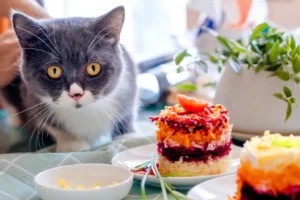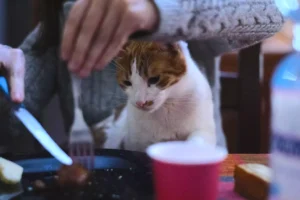Cats, the lords of the living room and queens of the couch. Sometimes, it seems their mood swings are as varied as their diets. Are the two connected? Maybe more than you think.
In this post, we’ll explore how what you feed your cat and when can really shape their behavior, turning those puzzled meows into purrs of appreciation.
Key takeaways:
- Balanced nutrition tailored to your cat’s life stage and activity level ensures better behavior and health.
- Consistent feeding times reduce anxiety and discourage overeating, keeping your cat mentally stimulated and physically healthy.
- Watch for signs like lethargy, mood changes, or poor coat quality as indicators your cat’s diet may need adjusting for their well-being.
What Does Nutrition Have to Do With Behavior?
You may not realize it, but the saying “you are what you eat” applies just as much to our feline friends as it does to us. Nutrition plays a pivotal role in your cat’s behavior, shaping everything from their mood to their energy levels. When your cat’s diet hits the right nutritional notes, it’s like sweet music to their system, harmonizing to keep them relaxed, alert, and ready to pounce (in a playful manner, of course).
Poor nutrition, on the other hand, can lead to a cacophony of problems. A lack of essential nutrients might leave your cat lethargic or, paradoxically, overly anxious. Too much of the wrong thing (like fillers found in some commercial cat foods) can contribute to obesity, which in turn can affect your cat’s energy levels and zest for life.
But here’s the kicker – the brain is as affected by diet as the rest of the body. Deficiencies in certain vitamins and minerals can impair cognitive functions, making learning new tricks or habits a tall order. Moreover, some studies suggest that an imbalance in the diet can contribute to aggression and other behavioral issues.
How Can You Tell if Your Cat’s Diet is Affecting Their Behavior?
Not sure if your cat’s diet is the root cause of their latest curtain-climbing spree or midnight zoomies? Here are a few signs that nutritional issues might be playing a part:
- Unexpected Aggression or Irritability: If your chill cat is suddenly all hisses and claws, it might be time to reassess their diet.
- Changes in Energy Levels: A cat that’s more sloth than sprinter could be lacking essential nutrients or, conversely, dealing with the crash after a high-carb meal.
- Excessive Sleepiness: While cats are known for their love of napping, needing too much sleep can indicate poor nutrition.
- Lack of Interest in Food: This could signal that the current menu is not meeting their nutritional needs.
What Are the Best Feeding Practices to Promote Healthy Behavior?
So, you’re convinced nutrition is key and you’re ready to act. Here’s how you can ensure your cat’s diet is tuned to promote a harmonious blend of good health and behavior:
Aim for Balance: Look for cat foods that boast a complete and balanced nutritional profile, adhering to the guidelines set by the AAFCO (Association of American Feed Control Officials). Consider incorporating wet food into their diet, as it’s often higher in protein and moisture than kibble, which is great for their urinary tract health.
Consider Meal Timing: Cats are natural hunters, and feeding them at consistent times can help replicate the routine they might follow in the wild. This doesn’t just satisfy their hunger – it provides structure and reduces anxiety. Plus, setting specific feeding times can prevent overeating by discouraging grazing.
Adjust for Age and Activity Level: A spry kitten has different nutritional needs than a senior cat. Likewise, a furry couch potato shouldn’t eat the same portion size as an adventurous outdoor cat. Tailor your cat’s diet to their life stage and activity level to keep their behavior and health in check.
Engage Their Brain: Here’s a unique tip – try using puzzle feeders to make mealtime more stimulating. These nifty gadgets make your cat work for their food, engaging their brain, satisfying their hunting instinct, and preventing gobbling. It’s a win-win!
By feeding your cat a balanced diet tailored to their needs and keeping an eye out for signs of nutritional imbalance, you’re not just filling their belly – you’re nurturing their mind and spirit. Remember, a well-fed cat is a happy cat, and a happy cat makes for a harmonious home, where both you and your fuzzy companion can thrive.
Can Changing My Cat’s Diet Improve Their Behavior?
Ever found yourself pondering whether the key to unlocking a happier, healthier, and more harmonious life with your feline friend lies in their food bowl? Well, you’re not alone. Many pet owners have witnessed the immense impact that diet can have on their cat’s behavior. From mood swings to energy levels, it turns out that what goes into your cat’s stomach can indeed influence their day-to-day conduct.
The Link Between Diet and Behavior
Before we dive into the tales and testimonials, let’s briefly unpack the science behind it.
Cats are obligate carnivores, meaning their bodies are fine-tuned to derive nutrition primarily from meat. However, the modern-day, shelf-stable convenience of some cat foods can mean that essential nutrients may be less available in their diets, which can have subtle to startling effects on their psychological well-being and behavior. Adjusting your cat’s diet to ensure they’re receiving adequate protein, fats, and specific vitamins can improve their mood, energy levels, and even cognitive function.
Real-Life Transformations
Case Study: Miss Whiskers Finds Her Mojo
Let’s talk about Miss Whiskers, a once lethargic and standoffish tabby, whose life took a 180-degree turn when her owner decided to shake things up in the diet department. After consulting with a vet, Miss Whiskers was transitioned to a diet replete with high-quality, wet food that was closer to what her ancestors would eat in the wild – rich in protein and moisture, and low in carbohydrates.
The results? Within weeks, Miss Whiskers transformed from being a couch potato into a playful and energetic companion. Her coat became shinier, she was more engaged with her surroundings, and her nighttime zoomies reduced significantly, making for a happier cat and a well-rested owner.
Signs It’s Time for a Change
How do you know if it’s time to reconsider your cat’s diet? Look out for signs like:
- Lethargy: If your cat’s become a bit too fond of their nap times, lacking the energy they once had.
- Mood Changes: Is your kitty acting more like a sour puss than their usual purr-sonality?
- Coat Quality: Dull, lifeless fur or excessive shedding can be a distress signal from their body.
- Digestive Issues: Frequent upset stomachs or changes in appetite can indicate their diet isn’t sitting well.
Unique Insight: The Social Eater
Here’s a nugget of wisdom that often flies under the radar: some cats are social eaters. Yes, you read that right. Much like some people prefer company during meals, some cats too thrive when they eat in the presence of their favorite humans. This doesn’t mean you have to dine on the floor next to them (unless you want to, of course), but simply being present, offering a gentle stroke, or talking to them while they eat can vastly improve their mood and thus, their behavior.
It’s a small adjustment that can make meal times a more positive and comforting experience for your feline, potentially easing any anxiety and making them feel more secure and loved.
Taking the Leap
If you’re considering a diet overhaul for your cat, remember:
- Consult a Vet: A vet can provide personalized advice based on your cat’s health profile.
- Research: Look for high-quality foods that match your cat’s nutritional needs.
- Transition Slowly: Gradually introduce new foods to avoid gastrointestinal distress.
Your cat’s diet is more than just sustenance; it’s the cornerstone of their well-being. By paying close attention to their nutritional needs, you’re not just filling their belly; you’re nurturing their spirit and molding their behavior. So, dare to make that change. Who knows? The road to your cat’s best life might just begin in their food bowl.
Alex, a passionate animal lover, has experience in training and understanding animal behavior. As a proud pet parent to two dogs and three cats, he founded AnimalReport.net to share insights from animal experts and expand his knowledge of the animal kingdom.










